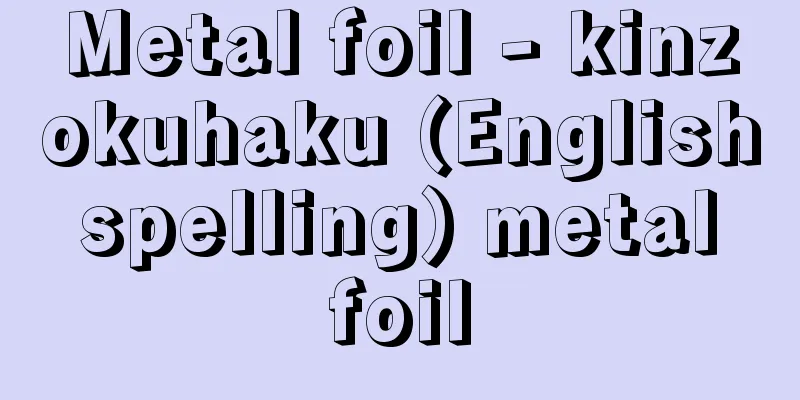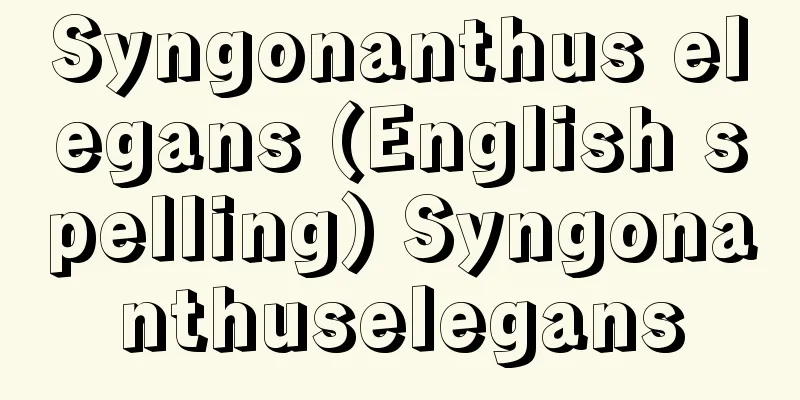Metal foil - kinzokuhaku (English spelling) metal foil

|
A highly malleable metal that has been rolled out into a thin paper shape. The standard thickness varies from country to country, but it is generally less than 0.2 millimeters. Metal foil has a very long history; for example, the gold leaf of Tutankhamun in Egypt was 1 micrometer thick, and a gold leaf craftsman is depicted in a mural inside the pyramid. The history of metal foil in Japan began at roughly the same time as Buddhism was introduced from China. In recent years, in 1919 (Taisho 8), it became possible to roll long lengths of tin and lead foil, which were mainly used for lining the insides of tea boxes and for wrapping cigarettes. Aluminum foil, which was first successfully produced in 1931 (Showa 6), is now used in large quantities for food and pharmaceutical packaging, electrical equipment, building materials, and household use, and is the most important of all metal foils due to its low price. Tin foil can be made as thin as about 0.25 micrometers, and was used as is or with paper attached to it for moisture-proof packaging of food, medicines, films, etc., but in recent years it has been replaced by aluminum foil. Aluminum bronze foil (containing up to 12% aluminum) and Western foil (copper containing 8-20% zinc) are used as substitutes for gold foil, and platinum foil is used for electrical resistors and high-end ornamental items. Recently, foils of hard metals such as stainless steel, titanium alloys, and nickel alloys have been produced using 20-high rolling mills with tungsten carbide work rolls, and many of these are used in electronic devices, etc. [Muneaki Shimura] [Reference items] | | |Source: Shogakukan Encyclopedia Nipponica About Encyclopedia Nipponica Information | Legend |
|
展延性に富む金属を薄紙状に打ち延ばしたもの。厚みの規格は各国により異なるが、だいたい0.2ミリメートル以下である。金属箔の歴史は非常に古く、たとえばエジプトのツタンカーメンの金箔は1マイクロメートルの厚さのものであり、また箔打ち職人の姿がピラミッド内部の壁画にある。日本の金属箔の歴史は中国からの仏教伝来とほぼ同時期に始まる。近年では1919年(大正8)にスズ箔、鉛箔の長尺の巻取り圧延が可能となり、これらはおもに茶箱の内貼(うちば)り、たばこの包装に用いられた。1931年(昭和6)に初めて生産に成功したアルミ箔は、現在、食品・医薬品包装用、電気機器用、建材用、家庭用などに多量に用いられ、また値段が安いので、金属箔中最重要のものとなっている。スズ箔は約0.25マイクロメートルまで薄くでき、そのまま、または紙を貼(は)って、食品、薬品、フィルムなどの防湿用包装に用いられたが、近年、アルミ箔にその位置を譲った。アルミニウム青銅箔(12%以下のアルミニウムを含む)、洋箔(銅に8~20%の亜鉛を含む)は金箔の代用とされ、白金箔は電気抵抗体や高級装飾品に用いられる。最近、タングステン・カーバイドの作業ロールを使用した20段圧延機を使って、硬い金属であるステンレス鋼、チタン合金、ニッケル合金などの箔が製作され、その多くは電子機器などに使用される。 [志村宗昭] [参照項目] | | |出典 小学館 日本大百科全書(ニッポニカ)日本大百科全書(ニッポニカ)について 情報 | 凡例 |
<<: Metal surface treatment - metal finishing
>>: Metal structure - Kinzokusoshiki (English spelling) structure of metal
Recommend
Mount Oza
A mountain in the southeast of Yamaguchi Prefectur...
Knights Templar of Jerusalem
…One of the three major knightly orders in mediev...
Living with her husband - Ottokatakyoju
…When the norm for marital residence is that it s...
Urartu - Urartu (English spelling)
An ancient kingdom that ruled a vast area centere...
Aretaeus of Cappadocia
A Greek physician who lived around the 2nd century...
Guillain-Barre syndrome
A disease that begins 1-2 weeks after cold symptom...
Simien jackal (English spelling)
...They live in family groups in relatively moist...
Kamei Rokuro Shigekiyo
…Yoshitsune and his party arrived at Hidehira'...
Hiuchinada
An area of the sea off the northern coast of Sh...
Edge (clothing) - En
… [Kasaya] The original purpose of the kesa was t...
Galleria (English spelling) (Italian)
A covered shopping street or pedestrian walkway. [...
Horse equipment - Bag
Humans first used horse meat as food, then domest...
Great barracuda
A marine fish belonging to the order Perciformes,...
Hammerhead shark
…It is also called Kase. Its English name is Hamm...
Nine Poems - Kyuukazu (English) Jiǔ gē tú
The subject of Chinese paintings. The Nine Songs a...









